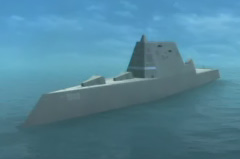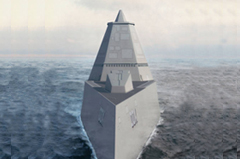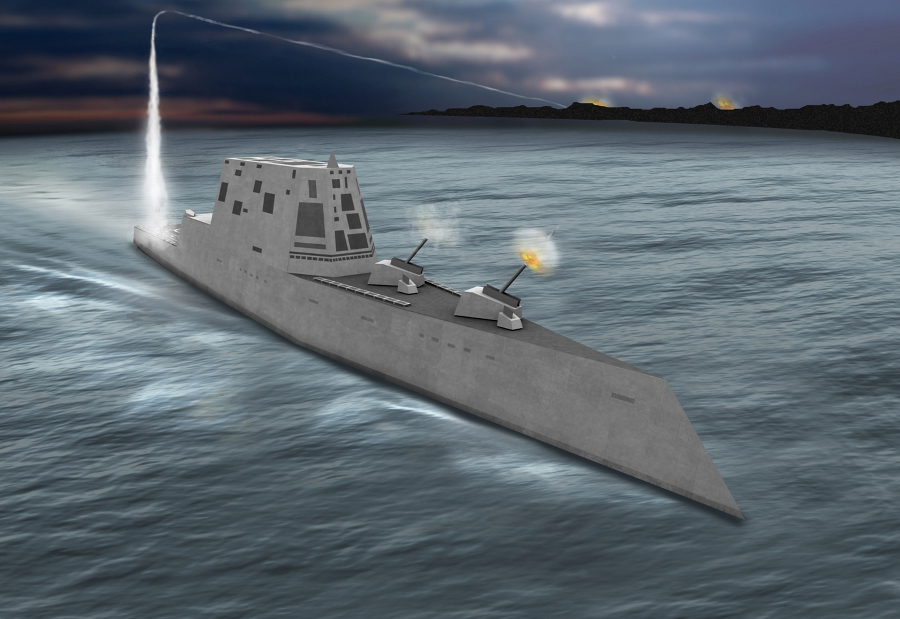|
|
|
|
..
DDG 1000 is America’s next generation, multi-mission, naval destroyer. Under the $3 billion DDG 1000 Detail Design and Integration (DDI) contract awarded by the U.S. Navy in May 2005, Raytheon continues its long-standing role as the prime mission systems integrator for DDG 1000. Driven by the vision – “Trusted Teammates Delivering an Overwhelming DD(X) ADVANTAGE to our Warfighters” – Raytheon carries overall responsibility for the design of all DDG 1000 electronic and combat systems. This website provides important information on the DDG 1000 program.
By partnering with scores of other top defense companies, Raytheon has effectively united a wide array of innovative and transformational technologies. The result is a ship capable of fulfilling multiple missions. Investigate the many leading-edge critical technologies built into the Zumwalt Class Destroyer |
|
|
..
Secretary of the Navy Donald Winter has announced that the lead guided missile destroyer in the ZUMWALT class will carry the designation and hull number DDG 1000. The lead ship and class are named in honor of former Chief of Naval Operations Admiral Elmo R. "Bud" Zumwalt Jr. Developed under the DD(X) destroyer program, ZUMWALT is the lead ship of a class of next-generation multi-mission surface combatants tailored for land attack and littoral dominance with capabilities that defeat current and projected threats and improve battle force defense. Special release from the U.S. Department of Defense Story Number: NNS060407-17
WASHINGTON (NNS) -- The Navy has announced April 7 that the first DD(X) destroyer will be designated DDG 1000. As the lead ship in the class, it will also be named in honor of former Chief of Naval Operations (CNO) Adm. Elmo R. "Bud" Zumwalt, Jr. Developed under the DD(X) destroyer program, Zumwalt is the lead ship in a class of next-generation, multimission surface combatants tailored for land attack and littoral dominance, with capabilities designed to defeat current and projected threats as well as improve battle force defense. Zumwalt was appointed Chief of Naval Operations in 1970. As the youngest man ever to serve as CNO, Zumwalt cemented an acclaimed reputation as a visionary leader and thoughtful reformer. July 4, 2000, then-President Bill Clinton celebrated Zumwalt's accomplishments and memory with the naming of the class and lead ship shortly after the admiral's passing in Durham, N.C., Jan. 2, 2000. Zumwalt was born in San Francisco in 1920 and grew up in Tulare, Calif. He was a cum laude graduate of the U.S. Naval Academy in 1942. As CNO, Zumwalt initiated wide-ranging reforms in a dramatic effort to revitalize the Navy. Time magazine hailed Zumwalt as "the Navy's most popular leader since World War II." As the Navy's senior officer, he increased the warfighting capabilities of the dwindling U.S. fleet by outfitting remaining ships with more efficient and sophisticated weapons. He retired in 1974. In 1996, he took over as chairman of the board of the U.S. Navy Memorial Foundation. In addition to numerous decorations received from the U.S. Navy, including the Navy Distinguished Service Medal (three awards), the Legion of Merit (two awards) and Bronze Star with combat "V," he received decorations and awards from a number of foreign countries. In 1998, Zumwalt was awarded the Presidential Medal of Freedom for his service to the United States. Zumwalt authored two books about his life in the Navy. On Watch (1976) recounts his Navy career and warns Americans about the Soviet naval threat. My Father, My Son (1986), co-authored with his late son, Elmo III, is an account of their Vietnam experiences and his son's tragic illness. Compared to current U.S. Navy destroyers, the Zumwalt-class destroyer will triple both current naval surface fire coverage, as well as capability against anti-ship cruise missiles. It has a 50-fold radar cross section reduction compared to current destroyers, improves strike group defense 10-fold and has 10 times the operating area in shallow water regions against mines. The Zumwalt class fills an immediate and critical naval warfare gap, meeting validated Marine Corps fire support requirements. Last year, Congress fully supported the DD(X) budget request, and the Zumwalt class is ready to start construction. In November 2005, the Department of Defense granted Milestone B approval, authorizing entrance into Phase IV of the program, including the detail design and construction of the two lead ships. Under the Navy's dual lead ship acquisition strategy proposed in the President's budget for fiscal year 2007, Northrop Grumman Ship Systems and General Dynamics Bath Iron Works will concurrently build the dual lead ships. Zumwalt will be delivered in 2012. This
is an official U.S. Navy Website
|
|
|
Total Ship Computing Environment Infrastructure Software TEWKSBURY, Mass., Nov. 7, 2006 /PRNewswire/ -- Raytheon Company (NYSE: RTN) has taken another important step advancing the U.S. Navy's Open Architecture (OA) computing initiative. The DDG 1000 software development team at Raytheon Integrated Defense Systems (IDS) delivered key DDG 1000 software components to the U.S. Navy's Program Executive Office for Integrated Warfare Systems (PEO IWS) ready for reuse in other Navy programs. A complete set of specifications, design documents, source code and user guides for the DDG 1000 Total Ship Computing Environment Infrastructure (TSCEI) Release 4.1 has been delivered and will be made available via the PEO IWS SHARE (Software-Hardware Asset-Reuse Enterprise) repository. DDG 1000 Software Director Bob Martin said, "Delivery of TSCEI 4.1 to the SHARE library -- with unlimited data rights -- is a significant step enabling the Navy to achieve its Open Architecture objectives for the fleet." The SHARE library institutionalizes OA principles and practices across the Navy enterprise. It ensures that all naval and joint programs and qualified Department of Defense vendors can access OA resources. TSCEI is an integrated suite of standardized OA hardware, operating system, middleware and infrastructure services. It forms the backbone of the Total Ship Computing Environment (TSCE). The TSCE is a robust, enterprise-network computing system on which all DDG 1000 application software programs run. TSCEI Release 4.1 builds upon the successful TSCEI 4.0 capabilities. It enhances software timer functionality and provides additional data collection capabilities. TSCEI 4.1 offers additional capabilities not only for DDG 1000 applications, but also for the entire OA community. As in Release 4.0, TSCEI 4.1 continues to show excellent performance characteristics while running on the IBM(R) Blade Server Processor suite. Under the Navy's DDG 1000 Detail Design and Integration contract awarded in 2005, Raytheon IDS serves as the prime mission systems equipment integrator for all electronic and combat systems for the DDG 1000 Zumwalt Class Destroyer program. Integrated Defense Systems is Raytheon's leader in Joint Battlespace Integration providing affordable, integrated solutions to a strong international and domestic customer base, including the U.S. Missile Defense Agency and the U.S. Armed Forces and the Department of Homeland Security. Raytheon Company, with 2005 sales of $21.9 billion, is an industry leader in defense and government electronics, space, information technology, technical services, and business and special mission aircraft. With headquarters in Waltham, Mass., Raytheon employs 80,000 people worldwide. Note to Editors: Exemplifying TSCEI OA virtues, Raytheon engineers and partners have already integrated a previous version of TSCEI (Release 3) with the OA version of Ship Self Defense System MK 2 (SSDS OA). On June 22, 2006, Raytheon announced that SSDS OA successfully passed formal qualification testing. This milestone enables the first delivery of a complete surface ship combat management system that meets the Navy's Open Architecture Computing Environment (OACE) standards. Through TSCEI reuse, the combat management system migrated to OACE Category 3. The system will undergo further developmental testing by Raytheon and the Navy in preparation for full production, planned for 2007. Initial deliveries are scheduled in 2008 for three ships: USS Nimitz (CVN 68), USS San Antonio (LPD 17) and LHA 6. In developing the TSCEI and TSCE, Raytheon has built upon available industry technologies to provide affordable "best-in-class" OA enterprise network solutions for DDG 1000 and the Navy's Family of Ships. Raytheon has actively cultivated partnerships with 33 software development sites employing more than 1,200 people. Raytheon has also engaged 12 Small Business Innovative Research program contractors and 42 commercial suppliers in the production of TSCE. Contact:
|
|
| FAIR USE NOTICE: This page contains copyrighted material the use of which has not been specifically authorized by the copyright owner. Pegasus Research Consortium distributes this material without profit to those who have expressed a prior interest in receiving the included information for research and educational purposes. We believe this constitutes a fair use of any such copyrighted material as provided for in 17 U.S.C § 107. If you wish to use copyrighted material from this site for purposes of your own that go beyond fair use, you must obtain permission from the copyright owner. | |
|
|




